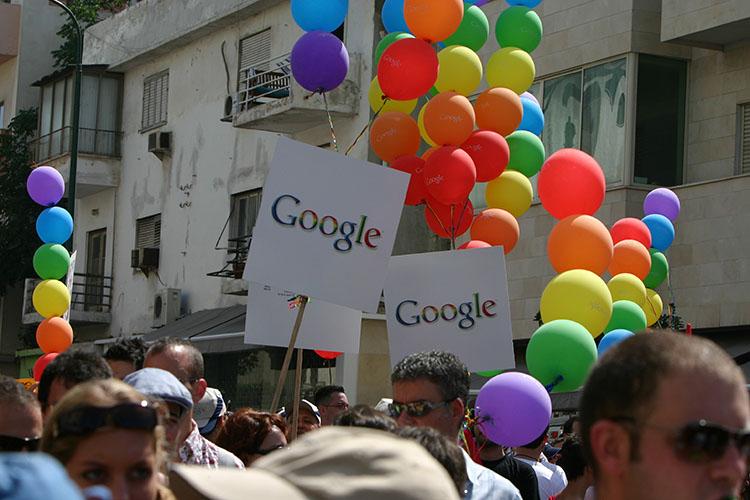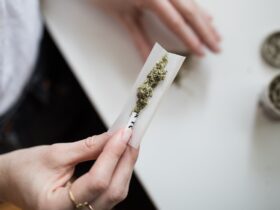It is the 50th anniversary of Pride, but you might be forgiven for not having noticed. Large events had already been canceled in anticipation of a prolonged pandemic, but the growing civil unrest that ushered in the month has had brands shifting their marketing strategy away from rainbows and towards their chromatic opposite: white text proclaiming Black Lives Matter against black backgrounds. With Pride quietly sidelined by its corporate stewards in favor of issues more pressing to the public, it’s never been more apparent that the movement has achieved its original objective: we’re here, we’re queer, and people have gotten used to it.
It’s all in stark contrast to last year’s Pride, where the relentless onslaught of Gay identitarian marketing seemed all but inescapable. Uber, a company notorious for the abysmal treatment of its “driver-partners,” published a post on its company blog called “Pride Comes in Many Colors,” in which various employees “tell their stories” against a backdrop of whichever flags were created to represent their identities (apparently the rainbow flag, once understood to be all-inclusive—hence the rainbow—is no longer inclusive enough). There’s a bisexual flag, a lesbian flag, a transgender flag, a genderqueer flag, an asexual flag, a pansexual flag, and a non-binary flag. In one post, an employee stood in front of the “polysexual” flag: “I’m attracted to a deep personal bond, I want to get to know who someone is as a person before I’m with them.”
Budweiser UK launched its own twitter-based ad campaign for Pride 2019, tweeting out a series of colored pint glasses made to resemble the same array of flags, each accompanied by a description for the uninitiated. “Black is for asexuals who don’t feel sexual attraction to anyone,” one caption begins. “Grey is for grey-asexuals, who sometimes feel sexual attraction, and demi-sexuals who only feel it if they know someone well. White nods to non-asexual allies, and purple represents the whole community.”
It isn’t that invagination into the capitalist relations of production has somehow degraded Pride, it is Pride.
The campaigns were roundly mocked on social media in the usual manner, a clarion call that has become, in its own right, an ineluctable part of the annual spectacle: brands pandering to Queer identities during Pride is transparently cynical! But there was also a backlash to the officious canonization of identities such as “grey-asexual” and “demi-sexual” into the LGTBQIA+ community. (This term itself a longstanding source of internecine conflict, with letters being added, removed, and rearranged to the point where it’s anyone’s guess as to what the accepted initialism is at any given time.)
What cultural overlap or claims of oppression does a gay man or a lesbian, for instance, share with an “Ace” (asexual) person who doesn’t really want to have sex with anybody, or an “Aro” (aromantic) person who previously might’ve been called a “commitmentphobe” by lovers or, more charitably, an “eternal bachelor?” For what purpose would one ever feel the need to proudly self-identify as a person who only desires sex so long as the conditions are right (i.e., the vast majority of human beings)? To those for whom the gay rights movement was once a life-and-death battle for legal rights, the expanding array of sexual micro-categories might seem little more than a gold rush for the badges of authenticity awarded to difference and victimhood under a newly liberal and gay-friendly cultural hegemony.
Perhaps this free-for-all of self-identification and the attendant demand that each be “visible” and “represented” is itself a sign that the quality of life for gender and sexual minorities has improved to such an extent that the whole notion of Pride, bereft of the conditions that occasioned it in the first place, is little more than a summertime trade expo in which shiny new product lines of identity are unveiled and tested for market receptivity.
But it isn’t that the churning process of invagination into the capitalist relations of production has somehow degraded Pride, it is Pride. This is just what legal and cultural liberation under capitalism looks like—the opening of a new market.
This is not to say that it can’t be a reason to have a good time. What makes the whole thing embarrassing isn’t so much the corporate corruption of Pride’s original significance, as groups like the Reclaim Pride Coalition insist, but the very insistence that there is anything to corrupt. Surely Saint Patrick’s Day, for example, which has long been absorbed into capitalism as a marketable cultural product, could also be injected with the academicized language of social justice and t-shirts reading “Remember the Potato Famine” or “Tiocfaidh ár lá!” instead of “Kiss Me I’m Irish,” but what material difference would it make?
Even Ball Culture, having since entered the mainstream through pop-cultural products like RuPaul’s Drag Race, was born not only from the maximally intersectional banishment of its participants from bourgeois society, but also as a performatized longing—however unthinkable the possibility once was—to be accepted into its fold. Now, as both gay men and gay women earn, on average, more than their straight counterparts, it seems Gayness is less a shared struggle against an oppressive, hierarchical social structure so much as it is a shared interest in securing and maintaining its position within it.
We are connoisseurs, aesthetes, taste-makers, fashion and beauty gurus, bourgeois liberal intellectuals, and otherwise ambitious careerists proving our worth to—and maybe at the expense of—the backwards, homophobic simpletons who had once been cruel to us in our youths. Today reconciliation comes in the form of Queer Eye’s Fab Five swooping down from their luxury lofts to put aside their trauma and offer heterosexual men a crash course in the tasteful cosmopolitan sensibility that largely defines the Gayness they represent.
That capital has subsumed the aesthetics of Gayness into their branding is not, as argued by anti-consumerists, a cynical attempt at exploitation or neutralization, but rather simply what liberation looks like for an identity ontologically bound to the mode of production in which it was created. In this way, aestheticized sexual identitarianism has much more in common with subcultural fandom communities than it does with the other kinds of potentially marginal identities—ethnic, religious, it purports to resemble. While the scientific consensus is that you can’t choose to be gay in the same way you can choose to be a Trekkie, you can choose to be Gay—that is, you can shape your patterns of behavior and consumption to signal to others that you are, in fact, Gay. But what would that mean moving towards a more egalitarian society in which appreciation of and access to “the finer things” isn’t increasingly restricted to well-to-do DINKs?
If the foundation of an identity is a reaction against the otherness and material disadvantage applied to a range of biologically-motivated behaviors, and that foundation is ruptured—as has largely been the case, at least in the large cities where the majority of Americans live—what remains? For the most part, it seems, an identity crisis: we have taken to doing openly and self-righteously to ourselves what giant tech platforms have been doing behind-the-scenes: endlessly categorizing and subcategorizing everyone in pursuit of a utopian identity-first capitalism wherein each individual can be pandered to at the most niche level, down to the forest-mammal designations of different body-hair-to-body-weight ratios (you better believe the “Bears” and the “Otters” have their own flags, too). Despite the rallying cry that these identities are unconditionally positive and good and liberational, and should therefore be recognized and appreciated on the (constantly fluctuating) terms that they set for themselves, they are in fact meaningful solely by virtue of performance insisting its own meaning.
Queerness, as differentiated from the mainstream LGBTQA+ community by its even laxer concern of actual biology and behavior in the setting of its parameters, speciously imagines itself in opposition to capital, though in fact can only offer a competing aesthetic, i.e., Brooklyn to the other’s Manhattan. Queerness, through its righteous ethos of radical inclusivity, reveals itself to be, essentially, nothing in particular. (Anyone—deliberately or not—can be Queer.)
Queerness, in fact, is the source from which the product line of boutique genders and orientations is continuously generated: pansexual, pangender, agender, demigirl/boy, neutrois, bigender, gender fluid, nonbinary, demiandrogyne, multisexual, asexual, androsexual, gynesexual, aromantic, and so on. As soon as a new category is created—often by semi-anonymous Tumblr users—it cannot be questioned. One’s own imagining of self is paramount; “erasure” is an unforgivable offense (as if one’s identity, like the sound of a tree falling, must rely on external affirmation in order to exist even to oneself), and to pose a critique invites excoriation as a bigot.
The irksome subtextual demand made by Queerdom is that cisheteronormativity be abolished in favor of the establishment of an equally arbitrary queernormativity: a world where everyone ends up with their own unique gender/orientation signature, each valid and worthy of compulsory celebration. That is to say: a world where all of this stuff matters in perpetuity. I, for one, would much rather it didn’t matter, because if Queerness can be anything, why should it be anything?
I don’t think it’s regressive to imagine a future in which Gayness ceases to be a thing beyond what it is biologically. Personally, I favor its complete irrelevance. Liberation, to me, is never having to think of myself as a gay man, much less as a Gay man. This is not self-loathing—I have no problem or shame with what being a gay person physically entails, and yes, I understand that, historically, it has been straight people who have forced the relevancy of gayness onto gay people. If it hadn’t been for the gay rights movement, the physical act of what the word denotes would still be something to be criminalized and pathologized. Of course there is an element of riding on the coattails of people who have legitimately fought against grave injustices, and, in doing so, have created a society where I have the privilege—to use that exhausted term—of even being able to write this without fear of being thrown into jail and chemically castrated.
But, through much effort, times have changed. General acceptance varies regionally, but in virtually any urban area in North America, I am simply not oppressed for being gay. Though there are still condemnable incidents of discrimination and outright violence, polling data indicate a level of societal tolerance that cannot account for my precarity (it goes without saying that demi-sexual people are as utterly safe as they’ve always been). I am, however, oppressed in the same way all working people are: squeezed by the tightening Vise-Grip of an economic system that overwhelmingly favors the world’s richest people, including such billionaire role models as Peter Thiel and David Geffen (both gay), Megan Ellison (lesbian film producer and Larry Ellison’s daughter), Giorgio Armani (bisexual) and Jennifer Pritzker (trans).
Having broadly achieved its original goals, the gay rights movement edges closer to self parody, insisting less on the kind of universal programs and overhauls that materially improve the lives of working people—gay or otherwise—but on being “seen,” “visible,” and “represented.” Oh, they see us all right! Every June becomes a marketing bonanza, and even the most historically antigay institutions signal their #Pride. The problem with trying to reclaim one’s identity from this injury is that, removed from the gears of capitalism, there is no identity left to speak of. Brands pandering to your identity is not an affront to your identity but rather the defibrillator that keeps your identity alive and relevant. If this seems bleak to you, perhaps it’s time to let it go.
(You might find it liberating.)









